Introduction
Dubrovnik is a city and seaport on the Adriatic shores of the Croatian region of Dalmatia. It faces the sea at the foot of rugged limestone mountains and is probably most well known for its medieval fortified walls. The modern name derives from dubrava, which means "oak grove". There are many historic buildings within the walls, including two monasteries, palaces, churches and a cathedral. With several old squares and a multitude of pedestrian-friendly streets, not to mention surrounding beaches, Dubrovnik is one of the Adriatic's most popular tourist destinations and the city is a UNESCO World Heritage Site. Its total population is approximately 43,000.
Dubrovnik is not only a popular stopping off point for cruise ships, but a must-see site for the visitor exploring the beautiful Dalmatian coast by road and also ideal for those wishing to take a short European city break; the city's main serving airport (Čilipi Airport) is just 15½ km (9½ miles) from the centre. The author of this webpage first stayed here for a one week holiday in the early 00's and returned for a few nights in 2016. The photos shown on this webpage are from the latter visit and it therefore supersedes an older page, which may be found Here.

Above: The city walls as seen from just west of the Old Town. Some readers may recognise Dubrovnik (of sorts), as the city was used as a template from which artists designed the more fanciful "King's Landing" in the HBO television series Game of Thrones. Dubrovnik has also been used as a set for filming Star Wars VIII. This international exposure has added to the increasing numbers of tourist visiting the city and resulted in some of the tourist shops now stocking less traditional forms of merchandise.
Page Contents:
In the 7th century, the old city of Ragusa (Ragusium) was founded on the site of modern-day Dubrovnik by Greek refugees who came from the Illyrian city of Epidaurum (Ragusa Vecchia). Their home, some 15km to the south, had been invaded and destroyed by Slavic incursions. The founders had been part of the Holy Roman Empire. Ragusa grew and prospered, becoming an important independent merchant republic, lasting for 700 years. Such was its importance, trade links were as far afield as Turkey and India to Africa (including the Cape Verde Islands) and even England in the Middle Ages; the Croatian-Slav city was at the time the envy of Venice, on the other side of the Adriatic. During the 16th century Dubrovnik (the names Dubrovnik and Ragusa co-existed for several centuries) had one of the greatest merchant fleets in the Mediterranean and it served as the chief cultural centre for the South Slavs until the 19th century. It came under the protection of the Byzantine Empire between 867 and 1205, then of Venice until 1358, followed by Hungary until 1526, and of the Ottoman Empire Despite this protection, it remained largely self-governing as an independent republic for many years.
The city was struck by a major earthquake in 1667 that destroyed many buildings, but the inhabitants were soon to commence the reconstruction work. Despite the city-republic surviving over many centuries due to the various forms of protection from outside, this was to come to an end in the early 19th century, when Napoleon abolished its independent status and the Congress of Vienna ceded the town to Austria in 1815. Following the First World War, Dubrovnik became part of the newly created Kingdom of the Serbs, Croats, and Slovenes (later Yugoslavia), under the terms of the Treaty of Rapallo (1920). During the Second World Way, the city was occupied by Italian and German forces.
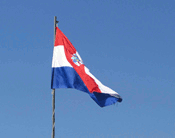
In 1991, when Croatia declared its independence from Yugoslavia, Serbian and Montenegrin forces laid siege to the city (until 1992). Famously covered by the news media at the time, the historic city was bombarded by the Yugoslav army. Many sites of historical importance were destroyed and much of the population was forced to flee. Today, Dubrovnik, with its characteristic red/orange roof tiles, has largely been beautifully reconstructed. Once again, it can be enjoyed by visitors and perhaps the medieval walls which stood the tests of late 20th century weaponry represent a symbol of the city's enduring strength.
Map courtesy of Openstreetmap.org
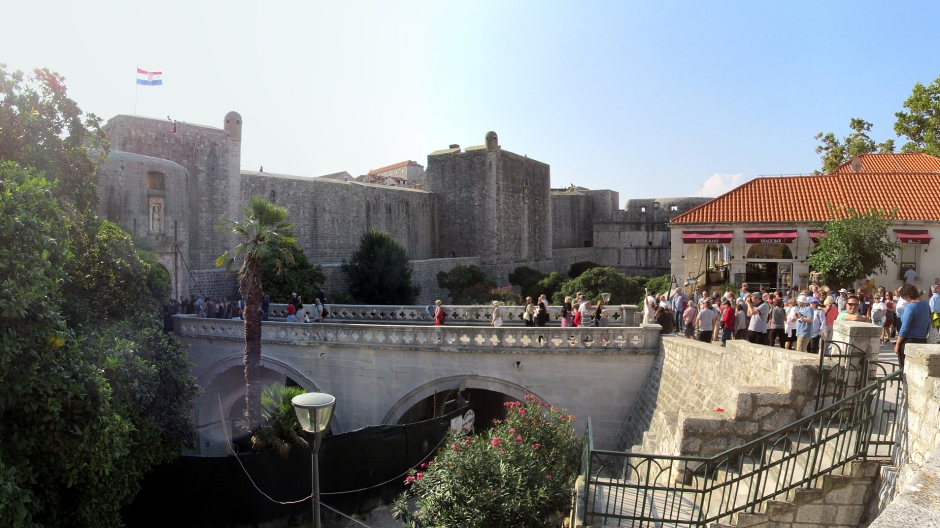
Shown in the panoramic stitch photo above is the main entrance to Dubrovnik's Old Town, the Pile Gate, which is on the western side of the famous city walls. The name comes from the Greek word pylaj, which means 'gate'. The Pile Gate was built in the 15th century in a semi-circular rampart and originally had a wooden drawbridge which would be pulled up at night-time to prevent unwanted guests from entering. During the days of old, the raising of the drawbridge each night would have been accompanied by a ceremony in which the city's keys would be delivered to the Ragusan rector. The drawbridge was replaced by a stone one many years ago and today, visitors entering the city through the Pile Gate will find themselves firstly walking across it over a small green passage, which was previously a moat.
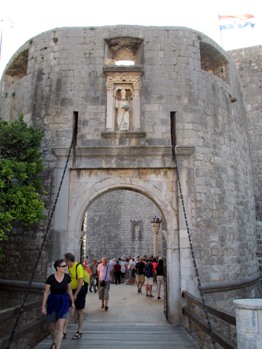 |
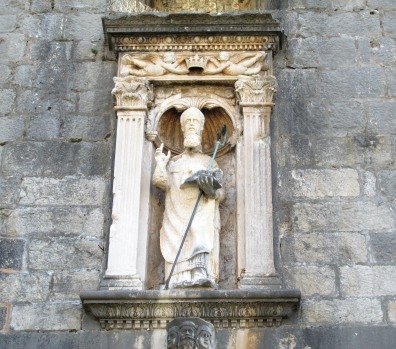 |
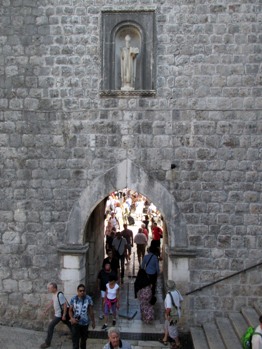 |
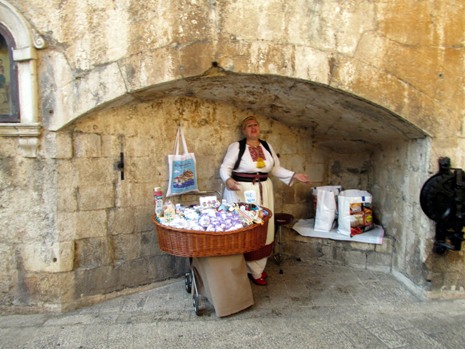 |
 |
The photos above show more of the Pile Gate as one passes through it. The gate is heavily fortified and on the outside was defended by the nearby Fort Bokar, one of several forts along the city wall. The gate comprises two Gothic arches which date from 1471 and so when entering the city, after crossing the bridge and passing through the first arch, steps (or a hairpin shaped slope) run down to the second arch. Through that, the entrance leads into a busy square, Poljana Paška Miličevića, and on to the western end of the city's main thoroughfare, Placa (The Stradun). Both of these are described further down the page. Over the arches can be seen statues of St. Blaise, whom is depicted holding a model of the Renaissance city. He was proclaimed the patron saint of the city of Ragusa, as it was known then, in 972, when his relics were brought here.
Above: On display at the Pile Gate is a city map showing the sites of damage caused by the aggression on the city by the Yugoslav army - the Serbs and the Montenegrins from 1991-92. Black triangles denote where roof damage was caused by a direct hit, burnt-down buildings are coloured in red, white triangles denotes roof damage by shrapnel, whilst black dots represent locations where a direct hit took place on the pavement.
It goes without saying, orange-tiled roofs aside, Dubrovnik is most famous for its spectacular city walls that run in their entirety around the Old Town. For those able to, it is possible to walk atop the walls, which spectacularly dominate the city, and certainly the best way to see the Old Town with its many streets, churches, monasteries and other historic buildings of interest. On the author's first visit to the city in the early 2000's, it was possible to walk along the walls in either direction and the price of a ticket far cheaper than today, where although still an experience not to be missed, it is only possible to walk in one direction, which is anticlockwise (counter clockwise) as viewed on a map. Along the route, there are three entry and exit points; the more popular being on the Old Town's western end, just on the left after entering the Old Town through the Pile Gate into Miličevića Square (by Sv. Spas/St. Saviour's Church), one at the tower of St. Ivan (John) to the south east of the Old Town and on the southern side of the Old Harbour, and the third at the north-eastern end of the Old Town at the Ploče Gate. The northern section of the city wall runs up and down the hillside and requires more climbing up and down steps, whilst the southern section runs along the more flatter side of town, on the seaward side. Thus beginning the walk at the Pile Gate end means walking along the southern section first, providing not only stunning views of the Old Town, but of the walls as they drop sheerly into the clear blue Adriatic Sea, before continuing upwards along the northern section, where the views become even more spectacular, seeing the Old Town from higher up and with the sea in the background for those all important photos. Speaking of which, the thumbnail gallery below shows photographs taken from a walk as just described (click on an image to enlarge). Some more information about these famous walls then follows.
The very well maintained city walls were the result of almost continuous construction work that took place from the 10th to 17th centuries. Throughout these years, there were ongoing improvements, reinforcements and additions made, many by famous architects and master builders. The walls are nearly 2 kilometres long with a thickness at the base ranging from 2-3 metres to 4-6 metres on the seaward and landward sides respectively (in some places, the thickness at the base can get even far greater). The defensive system of the walls was designed incorporating 3 round and 12 quadrangular towers, 5 ramparts, a fortress guarding the harbour (St Ivan's Fortress) and 2 corner fortresses. Further defences came in the form of a wide moat and a second wall with 10 semicircular ramparts on the landward side. Two standalone fortresses also guard the city either side - the 16th century Revelin (or Rivellino) Fortress just to the east and the 12th century Lovrjenac (St. Lawrence's) Fortress to the west of the walls. The former can be seen middle-top of photo 88 and the latter in photos 15, 28 & 36 in the thumbnail gallery above.
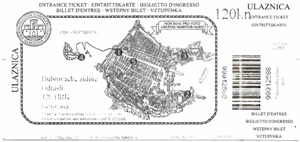
Beginning the walk from the ticket office at Sv. Spas/St. Saviour's Church (on Miličevića Square by the Pile Gate), the ascent soon rewards the visitor with views down the city's main thoroughfare, Placa [Photo 2] (further down the page). Turning roughly southwards, the walk atop the walls soon leads to Bokar Fortress [Photo 15, left], a 15th century circular construction which sits on the south-western corner of the city. Next, the southern section of the wall offers fine views of the sea (as well as the Old Town). Along the route, as seen in the photos, there are often many water-based activities going on, such as kayaking, jet-skiing and pleasure cruises. The southern section eventually leads on to the Fortress of St. Ivan (John) [Photo 83, looking back towards] which overlooks the Old Harbour on the eastern side of the city. From here, steps leading down enable the visitor to take a break via one of the three entrances/exits, before continuing along the next section of the city walls. Continuing the walk leads to the Tower of St. Luca (Luke), which along with the Fortress of St. Ivan protected the Old Harbour. The two fortresses, which were renovated in the 16th century, along with the late 15th century breakwater island of Kaša, were linked by a chain which would close the harbour to unwelcome boats. Now walking at the north-eastern corner of the Old Town, we reach the third and last entry/exit point, site of the 14th century Ploče Gate and the wonderfully named Azimov Tower. The Ploče Gate is connected to the nearby Revelin Fortress, which is a pentagonal structure, dating from the 15th century. Now walking along the northern section of the walls in a westerly direction from the Azimov tower, the walk passes five square towers which have semi-circular ramparts until reaching the Renaissance Minčeta Tower high up at the north-western corner of the Old Town [e.g. Photo 107]. The Minčeta Tower is an awe-inspiring round tower, built by Giorgio Orsini to a design by Michelozzo Michelozzi, a Florentine architect, in 1461-1465. It is possible to go inside and ascend it, where the views don't come any better and the visitor can truly feel the sheer amazement of Dubrovnik, this UNESCO World Heritage Site that is on full view from this vantage point. From the Minčeta Tower, the walls continue downwards before shortly returning to the exit/entrance near the Pile Gate. As a point of note, this walk is not for the feint hearted and given the number of steps involved, the choice of footwear should be considered - if in doubt, perhaps ask at the ticket office.
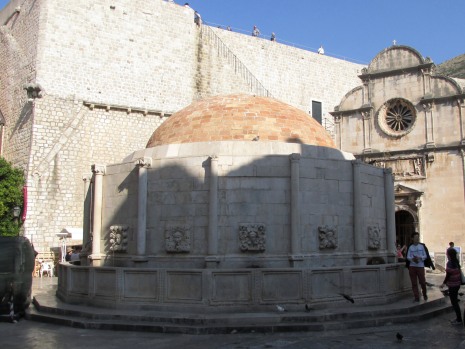 |
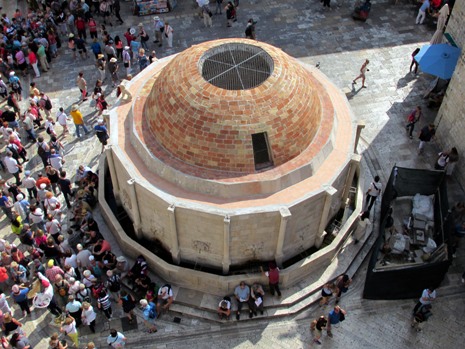 |
|
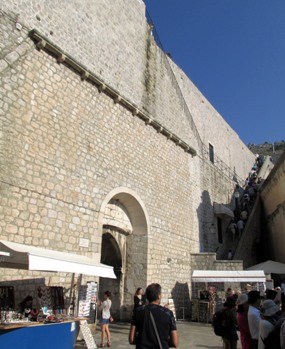 |
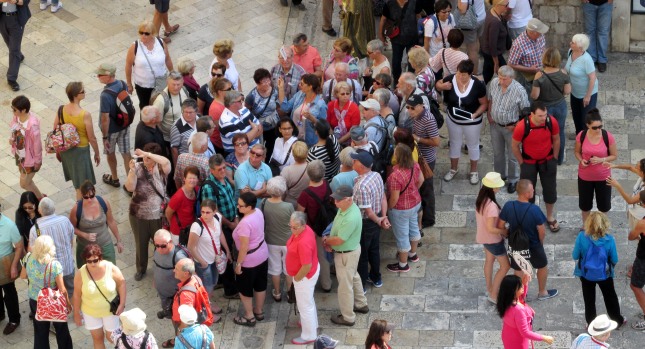 |
|
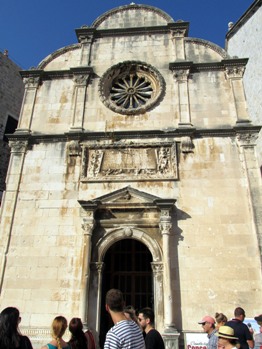 |
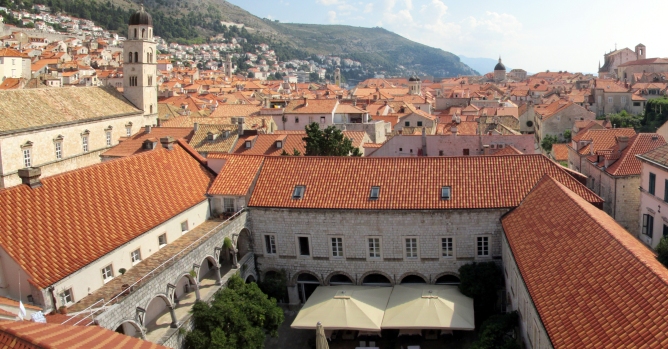 |
As mentioned further up the page, Poljana Paška Miličevića is a busy square and the visitor may well see for the first time after entering the city by way of the Pile Gate, which leads directly onto it. Here, it is not uncommon to see tour groups (some presumably from cruise ships) congregating as they have just walked into the Old Town. This otherwise attractive location within the city walls has at its ornamental centrepiece the (Large) Onofrio Fountain [top photos, above]. Rather unlike many typical fountains by design, it comprises a polygonal basin with a dome mounted on top, which has 16 almost gargoyle-like heads from which water spouts out into the basin. The fountain dates from 1438 and was designed by Onofrio de la Cava, a Neapolitan architect and sculptor who also designed a smaller fountain in the city's Luža Square (see below). Around Poljana Paška Miličevića are three buildings of note both historically and architecturally. On the southern side stands St. Claire's Convent (Samostan Sv. Klare) [bottom right photo, above] which was built in 1290, and rebuilt after suffering heavy damage in the 1667 earthquake. In 1432, it became one of the first orphanages in Europe, and it was later converted into a magazine during the Napoleonic period. On the northern side of the square adjacent to the city walls stands the small church of Sv. Spas/St. Saviour's [bottom left photo, above], previously mentioned as by the location of an entrance/exit point for walking around the city walls. The church was built between 1520 and 1528 and was one of the few buildings to survive the earthquake in 1667. It has a beautiful Renaissance Gothic Façade which is embellished by a rose window and sculptures. inside, there is an interesting Resurrection, dating from 1527, which was painted by Italian artist Pier Antonio Plermini. Immediately to the right of Sv. Spas/St. Saviour's Church stands the square's third building noted here, the Franciscan Church and Monastery. This is dealt with in some detail in the next section.
The Franciscan Church and Monastery
Dubrovnik is one of a handful of important sites of monasticism in Croatia. Several monastic communities settled here within its ramparts and whilst a Benedictine monastery on the close-by island of Lokrum lies in ruins, others, especially the Franciscan and Dominican convents, remain active. The Franciscans and Dominicans, mainly Italians, came here to form a centre of Roman Catholic missionary activity, competing with each other to spread their faith amongst the neighbouring strongly Orthodox Christian Serbs and non-Orthodox Bosnian Christians. Both the Franciscan and Dominican monasteries, despite being specifically targeted by the Yugoslav army in 1992-93, managed to keep many of their treasured collections safe, despite some parts of the buildings being damaged and today, both monasteries are open to the paying public.
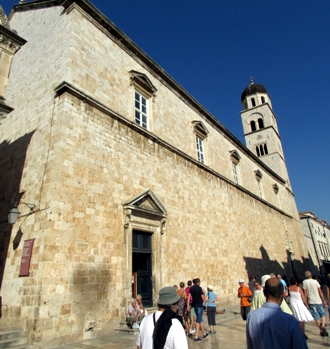 |
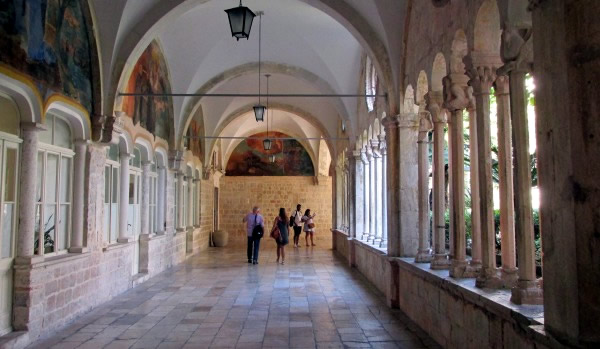 |
The two photographs above show the exterior as seen from Poljana Paška Miličevića, and part of the interior, of the Franciscan Church and Monastery (The Dominican Monastery is featured further down the page). The Franciscan monastery was built between 1317 and the end of the 15th century. However, it suffered heavy damage during the 1667 earthquake, especially its church. The church was rebuilt in the Baroque style and all that remains of the original Renaissance building is the south portal. This portal was carved in the Gothic style in 1499 by two brothers, Leonardo and Petar Petrović, who were also responsible for some magnificent statues which can be seen at the monastery. The Baroque interior contains a Renaissance marble pulpit which also survived the earthquake, exquisitely carved altars, a priceless organ, and also the tomb of prominent Croatian poet Ivan Gundulić (1588-1638). One of the main focal points of the monastery is the cloister, which was built in Romanesque-Gothic style between 1317 and 1330. Marble columns surround a courtyard on all sides, supporting arches each with different capitals. In the centre of the courtyard stands a statue of St. Francis on a fountain/well structure which dates back to the 15th century. Some details of the monastery, particularly the cloister, can be seen in the thumbnail gallery below:
It goes without saying, though, that one of the main attractions that lure tourists into the Franciscan Monastery sits on one side of the cloister and comes in the form of the monastery's pharmacy. The oldest in Eastern Europe, it was founded in 1317 and is still functioning today, making it the oldest one still in use on the continent today.. The rooms of the pharmacy were restored in the 20th century and today it is possible to buy somewhat more modern medications than those available in days gone by. It may be worth mentioning here that photography inside the pharmacy is not permitted, although included in the thumbnail gallery above is a photo of a picture of it [Photo 15]. The chapterhouse of the monastery contains a museum in which all manner of items relating to monasticism (and the pharmacy) are on display. Also here is a large collection of important manuscripts and volumes which belong to the monastery's extensive library.
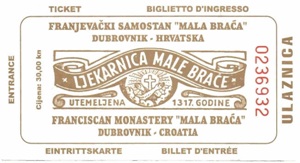
The Placa is the main thoroughfare which runs through the Old Town. It is commonly known as The Stradun, which derives from the Venetian word 'Stradòn', which means 'boulevard'. Roughly bisecting the walled town, The Stradun runs in a straight line west to east from Poljana Paška Miličevića to Luža Square (Loggia Square). With the two squares, both ends of the road are characterised by 15th century fountains (the Large and Small Onofrio Fountains) and bell towers (the bell tower attached to the Franciscan monastery to the west and the Dubrovnik Bell Tower to the east).
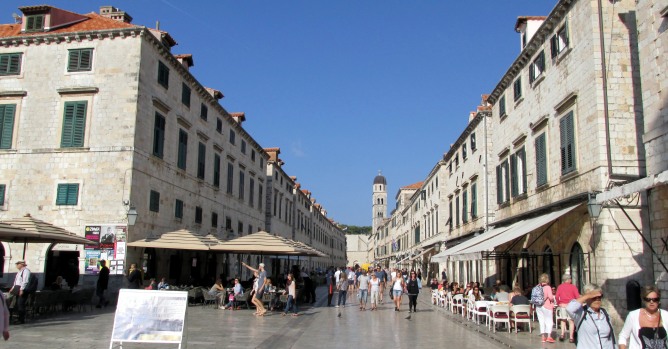 |
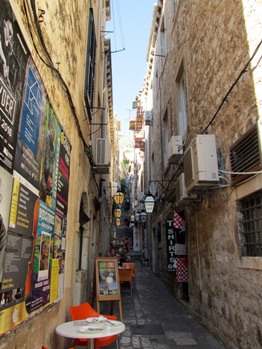 |
|
 |
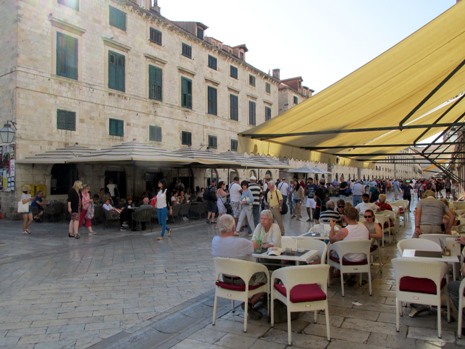 |
The upper left photo above shows Placa (The Stradun) at street level as
seen looking westwards from Luža Square, whilst the lower left photo
shows it as seen from outside the Franciscan Monastery looking eastwards
from Poljana Paška Miličevića. There are a large number of narrow side
streets running off The Stradun, many of which can be explored and
offering numerous outlets and one of these is also shown. A view of The
Stradun from above can be seen in the second photo of the City Walls
thumbnail gallery further up this webpage.
The Stradun, like most of
the Old Town, is pedestrian-friendly and is noticeably wide with respect
to the other roads. It dates back to the 12th century and was
constructed by filling in a canal that ran through the city and
eventually paved in the mid-15th century. Either side can be seen a long
row of elegant Baroque buildings and these were built in the years
following the 1667 earthquake, when wealthy local merchants opened up
shops along here. Today, the thoroughfare is lined with cafés, bars,
shops, galleries and so forth, and these are tastefully managed; don't
expect to find a popular fast-food outlet in this part of the city. It
is popular with locals and visitors alike. As mentioned, the side
streets are plentiful and those running northwards with their steep
uphill stairways are particularly atmospheric. One of these, Od
Sigurate, leads up to the pre-Romanesque Church of Sigurata, which was
built on the site of an even earlier church. Also to the north of The
Stradun lies the old Žudioska district, which dates back to the 14th
century. The synagogue here claims to be the second oldest one in Europe
still in use (after the one in Prague) and is situated in a 14th century
building.
As mentioned above, at the eastern end of the Stradun lies Luža Square (Loggia Square) and this is shown in the photos below. The square was the main centre of public life in ancient Ragusa and today remains a busy Old Town crossroads and cultural focal point of the city. The square is surrounded by some of the most decorative, historic and symbolic buildings of the city, including the Clock Tower, the façade of Sponza Palace, the Church of St. Blaise (Sv. Vlaho), the Rector's palace (Knežev Dvor), Marin Držić Theatre, the chambers of the city council (Dubrovnik's City Hall), and at the southern end, Dubrovnik Cathedral. Certainly an unmissable focal point of the Old Town, on the square itself also to be seen are Orlando’s Column and the Small Onofrio Fountains.
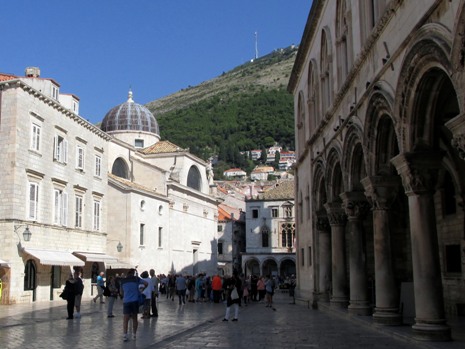 |
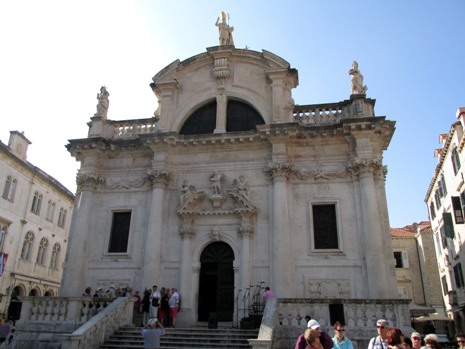 |
|
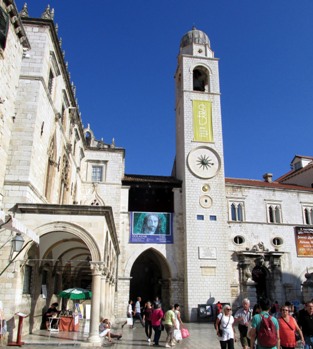 |
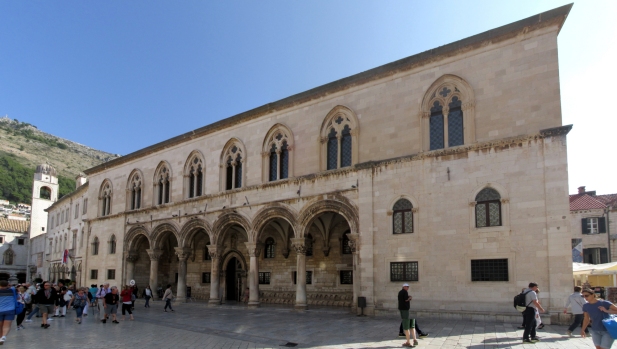 |
|
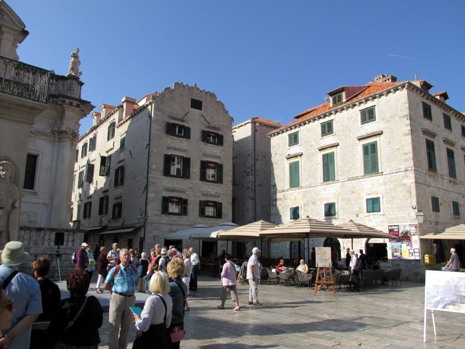 |
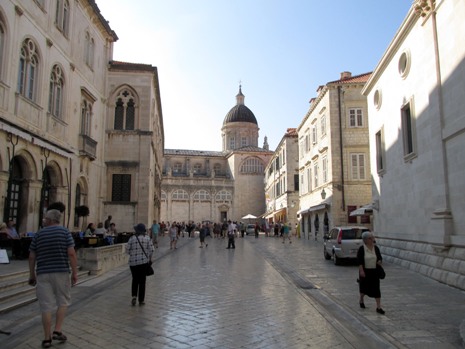 |
The 31m tall white Clock Tower, seen in the upper right photo above, was
built in 1444 and reconstructed in the 1920's. Two ancient bronze
statues on the tower strike the bell on the hour. Adjacent to the tower,
the Bell Loggia has four bells, which are rung in the event of danger,
or to summon the people of the city and next to this is the classical
façade of the main guard building. A niche nearby contains the
aforementioned Small Onofrio Fountain (designed 1438). To the left of
the white Clock Tower in the same photo above can be seen the Sponza
Palace, which lies on the northern side of Luža Square. The palace
houses the city's historical archives, although it was originally built
(from 1312) to house the Mint and customs offices. During the first half
of the 16th century, various alterations were made including the Gothic
and Renaissance elements of the outside we see today.
In the upper
middle photo above can be seen the Church of St. Blaise (Sv. Vlaho),
which is on Luža Square roughly opposite the Sponza Palace. The
building's ornamental façade makes this Venetian Baroque building a
distinctive feature of the square. The church was originally built in
Gothic style, but was destroyed by a fire in 1706 and subsequently
rebuilt from 1707 to 1715 to a design by Venetian architect Marino
Groppelli. Inside on the high altar is a locally made 15th century
silver statue of St. Blaise, the patron saint of the city. Like the
statues at the Pile gate, he is depicted holding a model of the city, as
it was before the earthquake of 1667. In front of the Church of St.
Blaise stands Orlando's Column, named after the heroic champion Orlando
who, legend has it, defeated a Saracen pirate who had laid siege to the
city. The column which includes a statue of Orlando was erected in
1418-1419 and became a symbol of the independence of the Ragusan
Republic.
Further south on eastern side of Luža Square is the
Rectors' Palace (Knežev dvor); a composite image of this is shown in the
lower left photo, above. As well as being a residence for the Rector,
the city's main governing body, the Great Council met here and official
ceremonies of the Republic of Ragusa were held here. The Rectors' Palace
was built in 1435 in Gothic style to a design by Onofrio, although was
badly damaged by an explosion in 1463. During subsequent restoration, a
six-arch Renaissance Gothic portico was added. The building also
suffered damage by the earthquake of 1667 There are many fine details to
be seen both on the outside and inside of the building which today
houses the Dubrovnik Museum. The museum is entirely devoted to the
history of the city and includes all manner of art works and objects,
such as furniture, documents, costumes and weapons. More information on
the Rectors' Palace may be found on an external link
Here. Now heading to the
southernmost end of the square, takes us to Dubrovnik Cathedral (Velika
Gospa), which is dealt with in the next section.
Dubrovnik Cathedral (Velika Gospa)
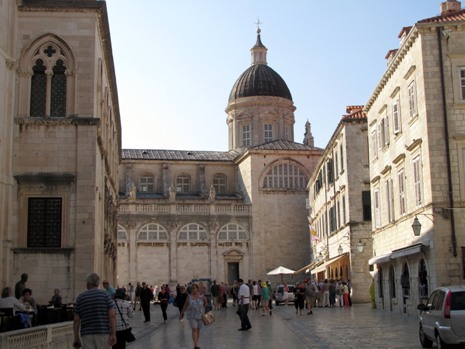 |
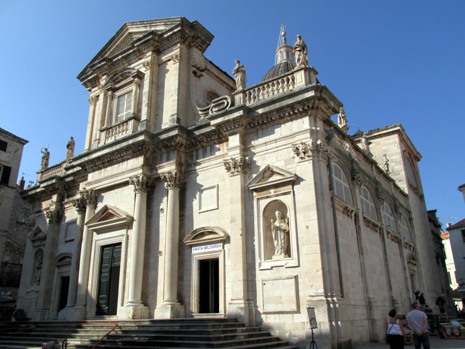 |
|
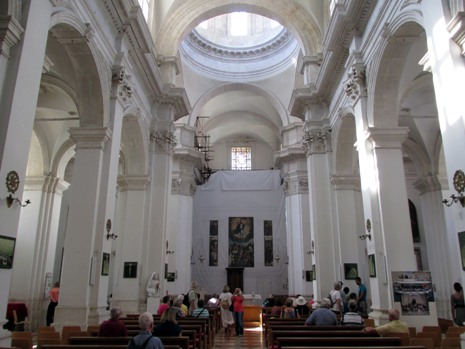 |
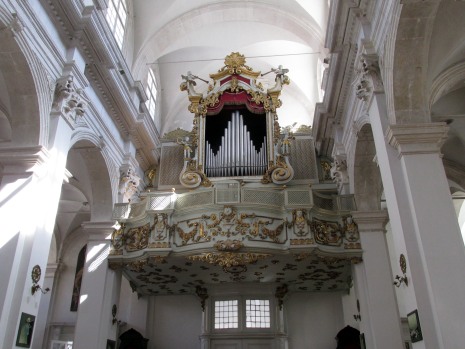 |
|
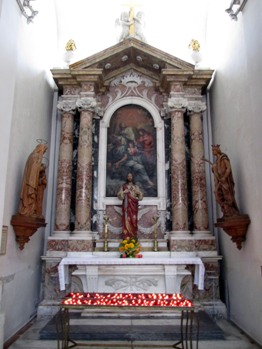 |
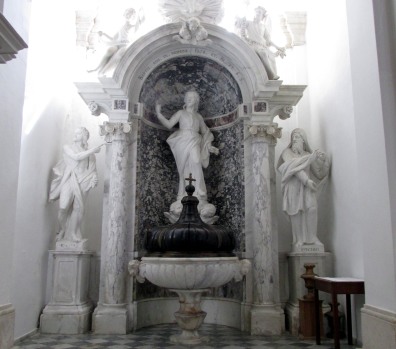 |
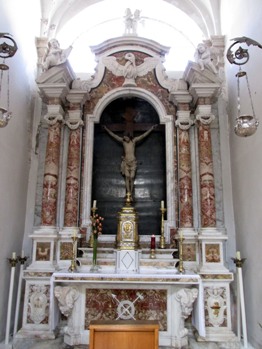 |
The photos above show the exterior and interior of Dubrovnik Cathedral, or to be more specific, The Cathedral of the Assumption of the Virgin (Velika Gospa). This Roman Catholic cathedral forms the seat of the Diocese of Dubrovnik and its roots stretch back to the 7th century. Archaeological excavations have shown that there were two older churches here - one a 7th or 8th century early Byzantine era Christian basilica which was probably rebuilt around the mid-10th century and the other, a magnificent Romanesque cathedral which was constructed around the mid-12th century around the walls of the original church. It is possible, according to some sources, that funding for the construction of this building came from Richard the Lion-Heart on his return from the Third Crusade, when he was shipwrecked of the close-by island of Lokrum, and this was in gratitude to the citizens of Dubrovnik for saving him. Unfortunately, this beautifully decorated building was another victim of the 1667 earthquake and it was completely destroyed. After the 1667 earthquake, rebuilding began shortly afterwards in 1672 and the magnificent cathedral we see today was completed in 1713. The design involved many Italian artists and architects, resulting in the building, which had a tall dome over a Latin cross plan and a nave with two aisles flanked by large marble altars. The Baroque interior is rich in treasures, including paintings by 16th to 8th century Italian and Croatian artists; particularly of note is an Assumption altarpiece on the high altar, which was painted by Titian in 1552. Also, in the treasury, there is a large collection of gold and silver religious articles most of which were made by Dubrovnik goldsmiths from the 11th to the 17th centuries. The reliquaries here contain parts of St Blaise, Dubrovnik's patron saint, and a fragment claimed to be part of the Holy Cross. This description of the treasures within the cathedral is just a taster for those interested.
Herb Square (Gondulićeva Poljana)
The thumbnail gallery below show photographs from Herb Square (Gondulićeva Poljana), followed by a walk along one of the Old Towns streets, Od Puča. Herb Square lies just west of the Rectors' palace and is used as a market place. It was built in the second half of the 17th century, where once stood buildings destroyed in the earthquake of 1667. Overlooking the market stalls, which sell flowers and fresh food items, can be seen a monument dedicated to Ivan Gundulić (1589-1638). Gundulić was the most prominent Croatian Baroque poet of his time from the Republic of Ragusa. His bronze statue stands atop a decorative plinth and dates from the 19th century. Looking beyond the square to the south is the Church of St. Ignatius (the Jesuits) and Colleguim Ragusinum (Crkva Sv. Ignacija i Collegium Ragusinum). The church and it's adjoining college form a fine complex on an elevated square and the church itself was built between 1667 and 1725 by architect Andrea Pozzo. They can be reached by walking southwards from Herb Square along Uz Jezuite.
Walking westwards from Herb square, takes in Od Puča, a busy street full of gift shops and side street restaurants which run to the north and south of it. Od Puča runs parallel to the Stradun and along here can be seen the Church of the Holy Annunciation and Museum of Icons. This Serbian Orthodox Church was built in 1877 but was heavily damaged during the 1991-92 Siege of Dubrovnik; it was carefully restored in 2009. Of course, the Stradun aside, Od Puča is just one example of the many streets in the old walled city that one may find themselves wandering down. It is perhaps suited to the visitor who prefers to stay on the flat and it may well be the case that a stroll around this pedestrian-friendly historic city takes a different route. In any event, though, there's nothing better (in the author's opinion) to be able to take some time just to wander around wherever it may be that takes your fancy, with no particular fixed route planned.
 |
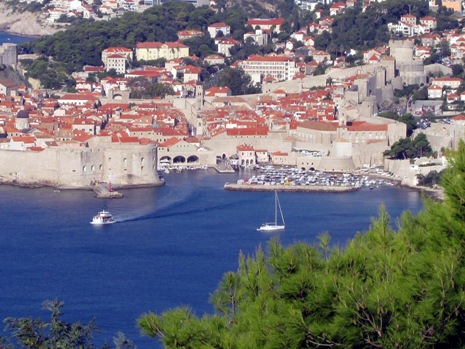 |
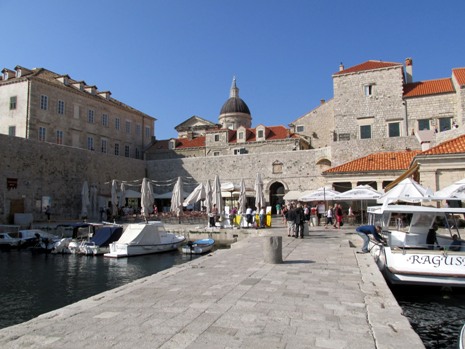 |
|
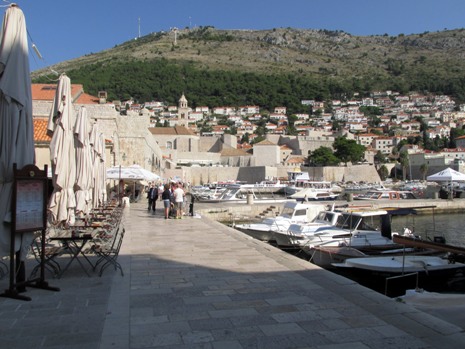 |
 |
|
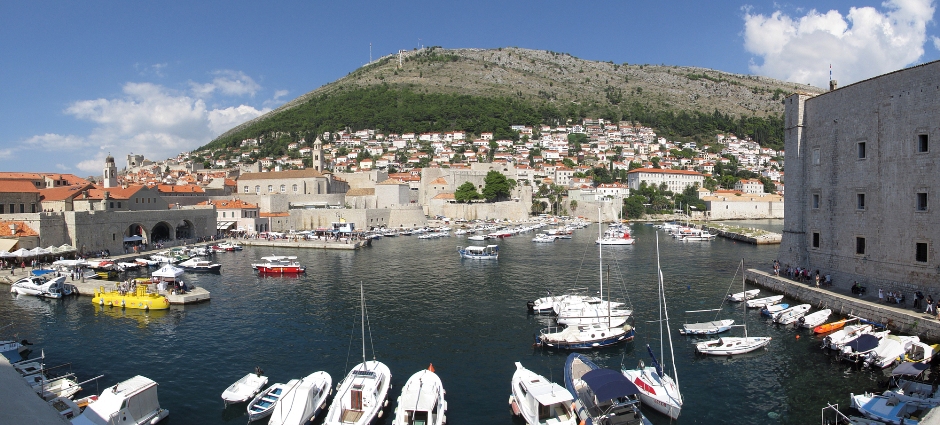 |
The photos above show more of the Old Harbour, previously mentioned in the description of a walk around the City Walls, further up the page. The top and bottom photos are panoramic composite images. Here, on the eastern side of the Old Town, just outside the City Walls, the ships of the Maritime Republic would have moored up and would have been a centre of trade as goods were loaded and unloaded. The three arches above the glass boat seen above were the site of the ancient arsenal. The harbour was defended by the tower of St. Luca (Luke) and the Fortress of St. Ivan [on the right of the bottom photo], as well as the Revelin Fortress. The Fortress of St. Ivan houses the Maritime Museum, which outlines the historical development from a naval context of the Republic of Ragusa (Dubrovnik later on). Also in the same fortress is housed the Aquarium, in which can be seen the flora and fauna of this part of the Adriatic. The Old Harbour makes for a pleasant place to sit and enjoy a beverage, or to take a pleasure boat from. It may be worth mentioning that anyone stopping at Dubrovnik on a cruise ship, should not expect to be arriving here! Large modern luxury liners dock some way off to the west of the Old Town.
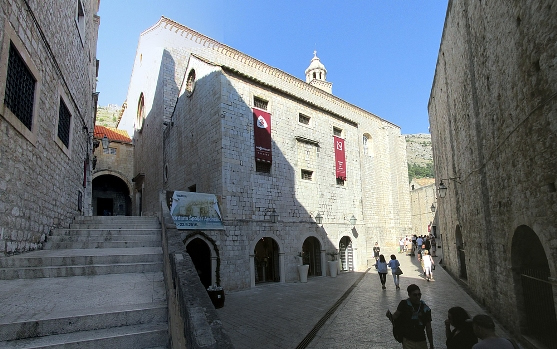 |
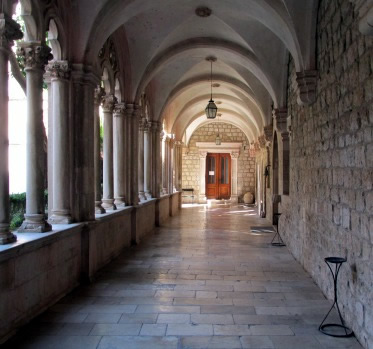 |
|
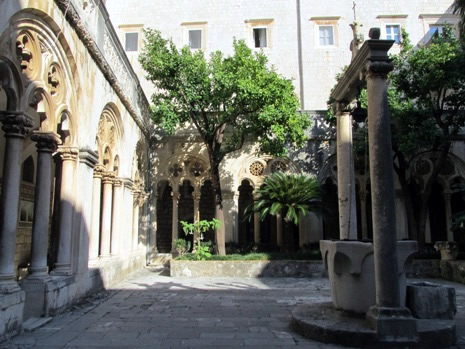 |
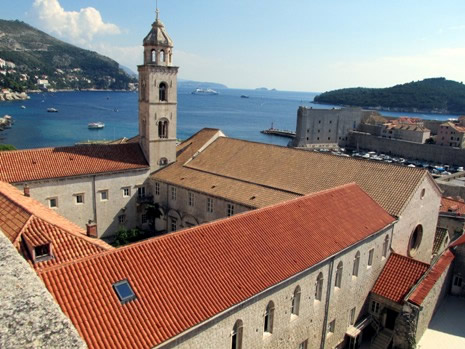 |
The photos above show the aforementioned Dominican Monastery (Top Left - Composite image as seen on the approach from the eastern end of Placa, Bottom Right - as seen from atop the city walls). Taking the side of the Old Town north of Placa, The Dominican Monastery is more or less at the opposite end from the Franciscan Monastery and it is approached via a staircase which is characterised by its stone balustrade. A Dominican Priory was founded here in 1225, although the current Dominican church and monastery were built between the 14th and the 16th centuries. It is perhaps the most important building in the city both for its architecture and the treasures housed within. The beginning of its construction in 1315 was of interest to the local (Ragusan) government, due to the site's strategic position against the city's fortified walls and so they helped with financing the project. Many local and foreign craftsmen were involved in building the church and monastery, which was incorporated into the city walls so as to strengthen its north-eastern flank. Several renovations and additions took place in the 15th and 16th centuries, however, like many other buildings in the city, it was damaged by the earthquake in 1667 and had to be partially rebuilt, although most of its Gothic and Renaissance elements were kept. The monastery was used as a barracks during the Napoleonic period but was restored to its original state during the 19th century. There are several important elements of the building, which over the centuries has played an important role in the city's cultural and diplomatic activities. The church's bell-tower, which was built from the late 14th century to the first half of the 16th century is a major landmark in the Old Town. On one side of the tower is the south portal of the Dominican church. Romanesque in style, it was decorated in the first half of the 15th century with a Gothic moulding and a relief portraying St. Dominic. These were made by the famous Italian architect and sculptor, Bonino da Milano. The interior of the church has no aisles and is simple in nature, leaving plenty of space for some magnificent decorations; along with the museum, there are many valuable paintings of the Dubrovnik painting school from the 15th and 16th centuries on display, as well as many valuable sculptures and artefacts. Many works which were in the church are now in the museum and have been replaced by more contemporary pieces. Despite this, the church still contains some masterpieces such as a 14th century Crucifixion by the artist Paolo Veneziano. Tombstones of the floor of the church date from the period when the city's people were buried there. The photos in the thumbnail gallery below show some of the points of interest in the church and monastery:
The Dominican Monastery's cloister is a splendid work of Gothic architecture and dates from the second half of the 15th century. It was built by local craftsmen and designed by Florentine sculptor Maso di Bartolomeo. In the museum itself, which is adjacent to the cloister, as well as works from the church, there is a large collection of pieces by both local and foreign artists, such as those by painters who worked in the city during the Renaissance. Also to be seen here are examples of gold-work, and various artefacts relating to monasticism, including manuscripts and volumes owned by the monastery's library.

Whilst visiting the Dominican Monastery (for those interested, such as the author of this web page), adjacent to the entrance is the small, but far from empty, Croatian Naïve Art Gallery. Here on show are paintings of Naïve (Primitive) Art from well known artists of the Hlebine School (see Wikipedia Here) to those by more modern artists. Self-taught, individualistic and certainly different from many mainstream works, the paintings vary in theme from animals to buildings to local rustic scenes. The nation's main gallery on this style of painting is to be found in the capital city, Zagreb, although a simple Google image search for "Croatian Naïve Art" should give the curious reader an idea as to the style of painting on view at this particular gallery in Dubrovnik.
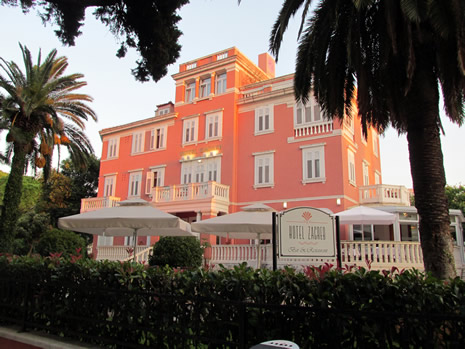 |
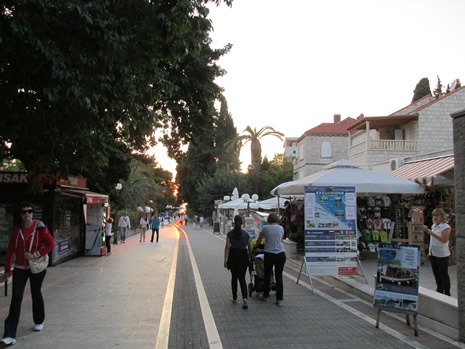 |
|
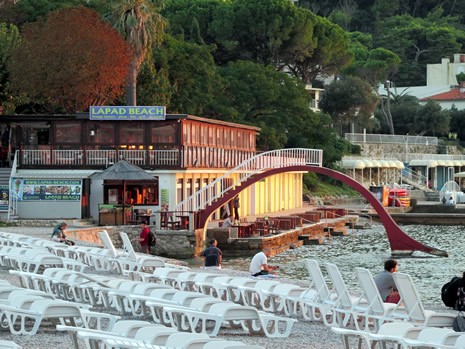 |
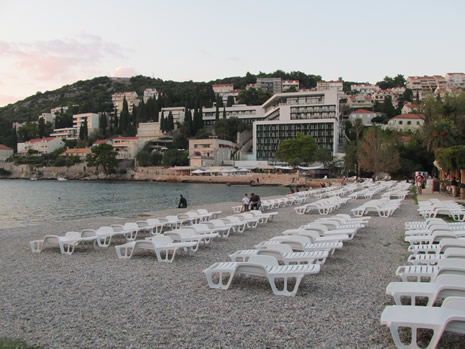 |
|
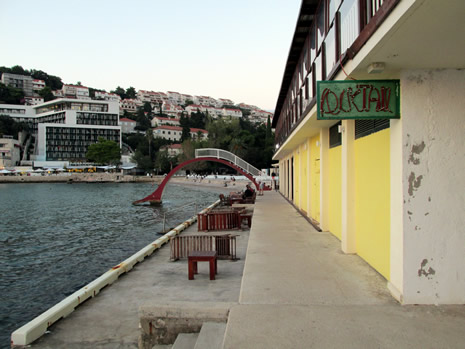 |
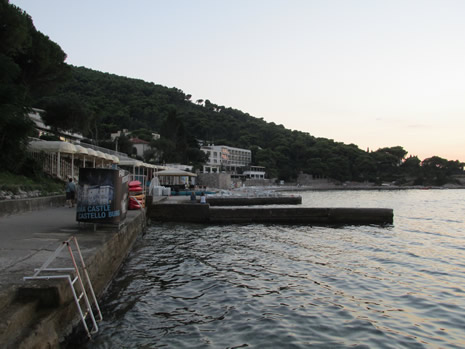 |
|
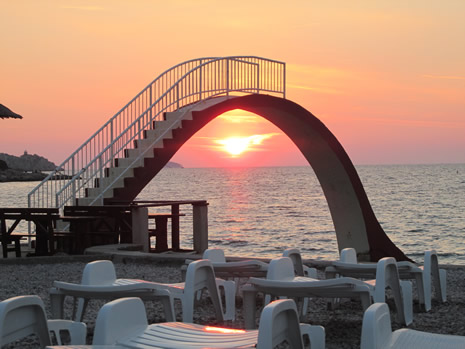 |
 |
The photos above are taken from Lapad, a large peninsula and (more) modern residential suburb that lies about 3km northwest of the Old Town. The area contains a large number of hotels, apartments and guesthouses, whilst still retaining the feel of a residential area. The restaurants, cafes and bars are frequented by both tourist and local alike. For anyone staying in Dubrovnik on holiday, Lapad is a popular choice. It is relatively compact and easy for walking around. Part of the main beach here, however, is managed and so there may be a small fee to pay to use one of the sun-beds. It might be worth pointing out that this part of the Adriatic (or indeed the Mediterranean) is not known for its sandy beaches, and here in Lapad, gravel is the norm. This does not, however, detract from the fact that this lush green location is sitting on a crystal clear blue sea which would be the envy of many other resorts. On the subject of staying here, as well as Dubrovnik's Old town, the area makes an excellent base for taking day trips out to other destinations, such as the bay of Kotor in Montenegro, the only Fjord in the Mediterranean, and also Mostar, with its famous bridge, In Bosnia and Herzegovina. Frequent buses run between Lapad and adjacent to the Old Town's Pile Gate (10 to 20 minutes journey time) ; getting to and from the airport though, requires a change of bus at Pile.
Mount Srđ and the Museum of Croatian War of Independence

Above: Excellent views of Dubrovnik and the surrounding area are today possible by taking a cable car to the top of Mount Srđ
The photos in the thumbnail gallery below are taken from an evening drive up to Mount Srđ, a 412 metre high rugged limestone mountain which overlooks the city. There is a cable car which runs from the Old Town up to an upper station, located at 405 metres above sea level. This was out of action during my earlier visit in the early 00's, due to being disabled during the aggression on the city by the Yugoslav army from 1991-92, but has subsequently reopened. It is also possible to walk up or down the mountain (seek further advice, for example locally, before proceeding). The mountain has been developed as a tourist attraction, with a restaurant and terrace for taking in the views of the Old Town, more modern suburbs of the city, Lokrum island, the Adriatic Sea. In addition, buggy safaris operate from here. On top of Mount Srđ stands Fort Imperial, which was built from 1806 to 1816 during the Napoleonic Wars. Inside here today, it is possible to visit one of the newer sights on offer, the Museum of Croatian War of Independence. The museum includes several rooms with visual displays, including a looping feed of television programming showing the News reports (British ITN) covering the bombing of the Old Town, which began on 23rd October, 1991. The bombing campaign was at a time the Yugoslav forces had moved into the region, implementing a sea blockade, and occupying areas including the airport and Mount Srđ, from which the shelling took place. Outside the fort are several dugout trenches still visible, where the Yugoslav forces held their positions. The mountainside was once covered in pine trees and also oak trees ("dubrava" - as mentioned near the start of this page, this is where the modern name Dubrovnik originated). However, in the second half of the 20th century and during the Croatian War of Independence (1991-95), fires left the mountainside deforested. On a final note, the views from Mount Srđ are certainly spectacular, and during the evening visit featured in the photos below, watching the sunset over the Adriatic Sea from this vantage point was a popular way to end the day.
References and Further Reading
1) In Situ Public Information Signs
2) In Your Pocket Kyiv (Kiev) City
Guide - A free indispensible guide to Kiev from the popular series and
downloadable from their webpage
Here
3) Old City of Dubrovnik on the
UNESCO website
Here
4) Barber, A., Strnad, K. and Howells, T.
(2001). Dubrovnik. Budapest: Somerset Kft.
5) Dubrovnik - New Complete
City Guide, Kina Italia
6) The Dominican Priory in Dubrovnik (2002),
Dominikanski Samostan Sv. Dominika
7) Glenny, M. (2000). The Balkans.
London: Granta Books
8) Johnston, W. (1999). Encyclopedia of
Monasticism. London: Fitzroy Dearborn.
9) Oliver, J. (2002). Croatia.
Hawthorn, Vic.: Lonely Planet.
10) Pervan, I. and Paljetak, L.
(2001). Dubrovnik njim samim. Split: Studio Pervan.
11) Ring, T. and
Salkin, R. (1995). International Dictionary of Historic Places. Chicago:
Fitzroy Dearborn
12) Travirka, A. and Radolović, M. (1999). Dubrovnik.
Zadar: Forum.
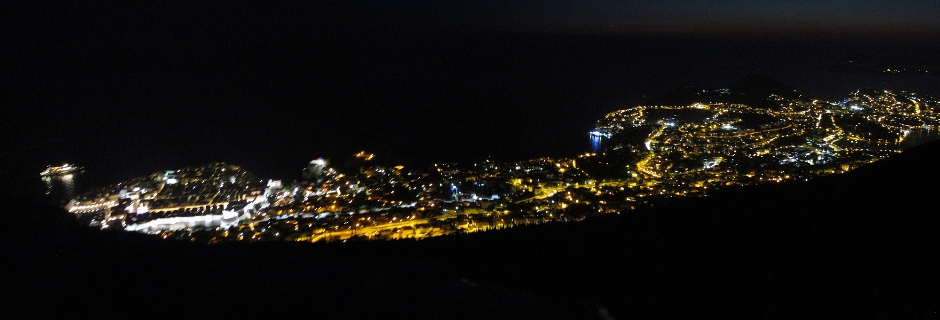
[Photos: 2016, Text: June, 2017]
Back to Top